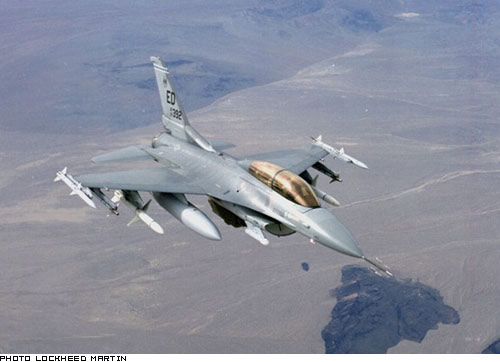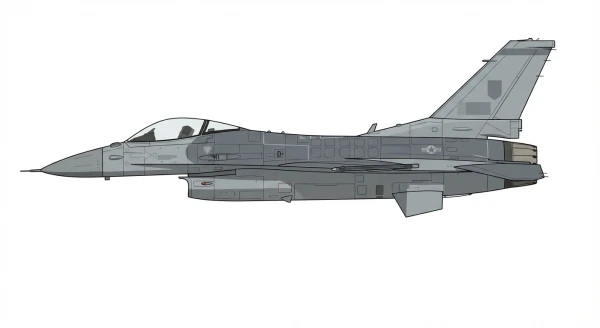F-16 Fighting Falcon
Summary
| Category | Combat Aircraft |
| Origin country | 🇺🇸 United States |
| Manufacturer | General Dynamics |
| First flight | 2 February 1974 |
| Year introduced | 1979 |
| Number produced | 4604 units |
| Average unit price | $18 million |
Description
The F-16 Fighting Falcon is a single-engine, multirole fighter aircraft originally developed by General Dynamics, which later became part of Lockheed Martin. It was first introduced into service with the United States Air Force (USAF) in 1978. The F-16 was initially conceived as a lightweight, daytime-only fighter, but later models expanded its role to include all-weather, multirole capabilities.
The development of the F-16 came about through the Lightweight Fighter Program, initiated by the U.S. Air Force in the early 1970s. The program aimed to develop a more affordable and agile aircraft as a counterpoint to the more complex and expensive fighters of the era, like the F-15 Eagle. The YF-16 prototype emerged as the winner of the program's competitive fly-off against the Northrop YF-17, and this success led to its eventual mass production.
The aircraft was revolutionary in several ways. It was one of the first to use a "fly-by-wire" control system and featured a side-mounted control stick and a frameless bubble canopy to enhance pilot visibility. Its relatively low cost and high adaptability have made it one of the most produced and widely used fighter aircraft in the world.
The design of the F-16 Fighting Falcon reflects its origins as a lightweight, multirole fighter. One of its most distinct features is the frameless bubble canopy, which provides the pilot with unparalleled visibility. The canopy sits atop a fuselage that is relatively slim, contributing to the aircraft's agility. Its single Pratt & Whitney F100 or General Electric F110 turbofan engine is housed in the rear, and the single-engine design contributes to its lighter weight compared to twin-engine fighters.
The F-16 features a side-mounted control stick, rather than the traditional center stick, offering the pilot easier control while under high G-forces. It was also one of the first aircraft to use a fly-by-wire control system, which replaces manual control with electronic signals, thus reducing weight and increasing responsiveness.
Aerodynamically, the F-16 incorporates a relaxed static stability/fly-by-wire flight control system, which enables it to pull off agile maneuvers that would otherwise be difficult or impossible. The aircraft's wing and fuselage are blended, improving lift and reducing drag, while its leading-edge flaps and trailing-edge flaperons are automatically adjusted by the flight control system to optimize performance during different phases of flight.
Armament
The F-16 Fighting Falcon is a highly versatile platform capable of carrying an extensive range of air-to-air and air-to-ground munitions. For air-to-air combat, it is often armed with AIM-9 Sidewinder short-range missiles and AIM-120 AMRAAM medium-range missiles. These can be supplemented by an internal M61 Vulcan 20mm rotary cannon for close-quarters combat.
For air-to-ground missions, the F-16 can be equipped with a variety of precision-guided munitions, including laser-guided bombs like the Paveway series, GPS-guided JDAMs (Joint Direct Attack Munitions), and AGM-65 Maverick air-to-ground missiles. It can also carry unguided "dumb" bombs and rockets.
The F-16 can also be fitted with various pods to enhance its capabilities. These include targeting pods like the LITENING or Sniper XR for improved targeting and reconnaissance, as well as electronic countermeasure pods for self-defense against radar-guided threats.
The aircraft's hardpoints—usually six under the wing and three under the fuselage—allow for considerable flexibility in mission-specific loadouts. This enables the F-16 to perform a wide range of missions, including air superiority, ground attack, and suppression of enemy air defenses (SEAD).
The F-16's adaptability extends to its ability to carry specialized munitions, such as anti-ship missiles or even nuclear weapons, depending on the requirements of its operating country and mission profile. However, the aircraft does have payload limitations due to its single-engine, lightweight design; it cannot carry as much ordnance as some larger, twin-engine platforms.
Operational history
The F-16 Fighting Falcon has had an extensive operational history, seeing combat in a wide range of conflicts and serving with the air forces of multiple countries. It was initially introduced into service with the United States Air Force in 1978 and quickly became a mainstay of the USAF's tactical fighter fleet.
In U.S. service, the F-16 saw its first major combat during Operation Desert Storm in 1991, where it performed a variety of roles including air superiority, strike, and suppression of enemy air defenses (SEAD). It destroyed more than 30 Iraqi aircraft, primarily on the ground, and also attacked various strategic and tactical ground targets.
Since then, the F-16 has been involved in numerous other operations and conflicts. It participated in the Balkans conflicts of the 1990s, including Operations Deny Flight and Allied Force. In these campaigns, F-16s conducted air-to-ground strikes and provided close air support. The aircraft also saw action in Afghanistan as part of Operation Enduring Freedom and in Iraq again during Operation Iraqi Freedom, carrying out multirole missions.
Beyond the U.S., the F-16 has been exported to more than 25 countries, and some of them have used it in regional conflicts. For instance, Israeli F-16s have seen extensive combat, being used in operations in Lebanon, Syria, and the Gaza Strip. Turkey has used its F-16s in cross-border operations against Kurdish positions in Iraq and Syria.
The F-16 has also been used by other NATO and allied countries in a variety of missions, from enforcing no-fly zones to conducting air-to-ground strike missions. The aircraft's ability to be easily upgraded has allowed it to stay relevant, and various models continue to serve worldwide, including in more recent conflicts like the Syrian Civil War.
Variants
- F-16A/B: These are the initial single-seat (A) and two-seat (B) versions. They were lighter and less expensive, designed primarily for daytime air-to-air combat.
- F-16C/D: These single-seat (C) and two-seat (D) variants introduced significant upgrades, including all-weather, multirole capabilities, advanced radar systems, and improved avionics. The C and D models have themselves undergone numerous block upgrades, each with incremental improvements in radar, avionics, and weapon systems.
- F-16E/F: Also known as "Desert Falcons," these are advanced versions developed for the United Arab Emirates. They feature improved avionics, conformal fuel tanks for extended range, and an enhanced radar system.
- F-16I: This is a variant customized for Israel, similar to the F-16D but with specific Israeli avionics and weapon systems.
- F-16V: This is the latest variant featuring an advanced AESA radar, upgraded mission computer, and improvements to the cockpit, among other enhancements. It can also be applied as an upgrade package to existing F-16s.
- F-16XL: A more experimental version with a cranked-arrow delta wing, intended to carry a heavier weapon load and possibly serve as a testbed for future designs. It was never adopted for mass production.
- F-16AM/BM: These are upgraded versions of older F-16A/B models, modernized mainly for NATO countries. The upgrades extend the service life and add capabilities similar to the F-16C/D.
Technical specifications
| Version: F-16C Block 30 | |
|---|---|
| Crew | 1 pilot |
| Maximum speed | 2410 km/h (1498 mph) |
| Wing area | 27.9 m² (300.0 sqft) |
| Wingspan | 10.0 m (32.7 ft) |
| Height | 4.9 m (16.0 ft) |
| Length | 15.1 m (49.4 ft) |
| Service ceiling | 18,288 m (60,000 ft) |
| Empty weight | 8,570 kg (18,894 lbs) |
| Max. takeoff weight | 19,200 kg (42,329 lbs) |
| Climb rate | 254.0 m/s (833.3 ft/s) |
| Powerplant | 1 x turbojet General Electric F110-GE-100 delivering 7777 kgf each |
| Ejection seat | McDonnell Douglas ACES II |
Current operating countries
| Country | Units | ||
|---|---|---|---|

|
United States | 875 | |

|
Turkey | 238 (+40) | |

|
Israel | 223 | |

|
Egypt | 218 | |

|
South Korea | 167 | |

|
Greece | 152 | |

|
Taiwan | 138 (+66) | |

|
United Arab Emirates | 76 | |

|
Pakistan | 75 | |

|
Singapore | 60 | |

|
Jordan | 59 (+12) | |

|
Belgium | 51 | |

|
Poland | 48 | |

|
Thailand | 47 | |

|
Chile | 46 | |

|
Denmark | 41 | |

|
Iraq | 34 | |

|
Indonesia | 32 | |

|
Bahrain | 28 (+7) | |

|
Romania | 26 (+23) | |

|
Portugal | 25 | |

|
Morocco | 23 (+24) | |

|
Oman | 23 | |

|
Ukraine | 19 | |

|
Venezuela | 4 | |

|
Slovakia | 2 (+10) | |

|
Argentina | 0 (+24) | |

|
Bulgaria | 0 (+16) | |

|
Philippines | 0 (+12) | |
All operators
Armament
Missiles payload:
- Anti-Radiation AGM-45 Shrike
- Air-to-Surface AGM-65 Maverick
- Air-to-Surface AGM-84 Harpoon
- Anti-Radiation AGM-88 HARM
- Air-to-Surface AGM-119 Penguin
- Air-to-Air Medium-Range AIM-7 Sparrow
- Air-to-Air Medium-Range AIM-120 AMRAAM
- Air-to-Air Short-Range Python 4
- Air-to-Air Short-Range Raytheon AIM-9 Sidewinder
Bombs payload:
- Cluster Aerojet CBU-87/B CEM
- Thermonuclear B61
- Guided Boeing GBU-39/B SDB
- Cluster CBU-89/B Gator
- Thermonuclear Livermore B83
- Low-Drag Mk 82
- Low-Drag Mk 83
- Low-Drag Mk 84
- Laser-Guided Raytheon GBU-10 Paveway II
- Laser-Guided Raytheon GBU-12
- Cluster Textron CBU-97/B SFW


